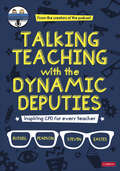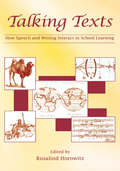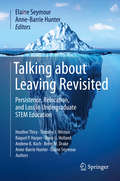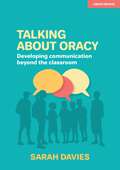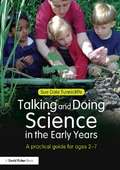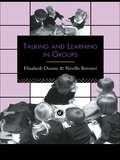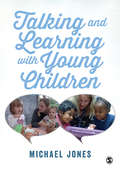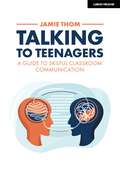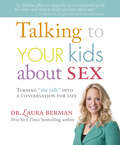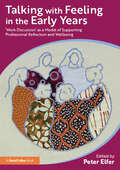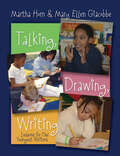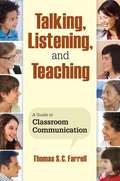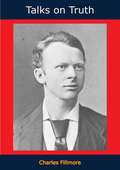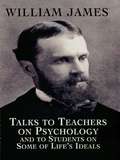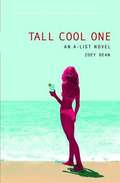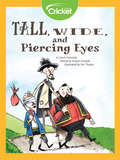- Table View
- List View
Talking Teaching with the Dynamic Deputies: Inspiring CPD for every teacher (Corwin Ltd)
by Russell Pearson Steve EastesTeaching remains an incredibly demanding and often ‘downtrodden’ profession but being a teacher can be a fabulous and rewarding job. This book offers uplifting professional learning for all teachers. It shines a light on the brilliant aspects of the job and helps readers to learn from some of the inspiring educators in the UK today. Russell Pearson and Steve Eastes are Primary Deputy Heads who run a popular education podcast for teachers. Interviewing educators for the podcast has shaped their understanding of key issues in education. *An uplifitng and inspiring learning tool for every teacher *Explores and unpicks lessons learned from ten inspiring educators *Focuses on key themes pertinent for all educators, regardless of their role or level of experience *Written in a truly authentic ‘voice’: from the perspective of real educators living and breathing daily school life
Talking Teaching with the Dynamic Deputies: Inspiring CPD for every teacher (Corwin Ltd)
by Russell Pearson Steve EastesTeaching remains an incredibly demanding and often ‘downtrodden’ profession but being a teacher can be a fabulous and rewarding job. This book offers uplifting professional learning for all teachers. It shines a light on the brilliant aspects of the job and helps readers to learn from some of the inspiring educators in the UK today. Russell Pearson and Steve Eastes are Primary Deputy Heads who run a popular education podcast for teachers. Interviewing educators for the podcast has shaped their understanding of key issues in education. *An uplifitng and inspiring learning tool for every teacher *Explores and unpicks lessons learned from ten inspiring educators *Focuses on key themes pertinent for all educators, regardless of their role or level of experience *Written in a truly authentic ‘voice’: from the perspective of real educators living and breathing daily school life
Talking Texts: How Speech and Writing Interact in School Learning
by Rosalind HorowitzThis volume examines how oral and written language function in school learning , and how oral texts can be successfully inter-connected to the written texts that are used on a daily basis in schools. Rather than argue for the prominence of one over the other, the goal is to help the reader gain a rich understanding of how both might work together to create a new discourse that ultimately creates new knowledge. Talking Texts: Provides historical background for the study of talk and text Presents examples of children’s and adolescents’ natural conversations as analyzed by linguists Addresses talk as it interfaces with domains of knowledge taught in schools to show how talk is related to and may be influenced by the structure, language, and activities of a specific discipline. Bringing together seminal lines of research to create a cohesive picture of discourse issues germane to classrooms and other learning settings, this volume is an essential resource for researchers, graduate students, classroom teachers, and curriculum specialists across the fields of discourse studies, literacy and English education, composition studies, language development, sociolinguistics, and applied linguistics.
Talking Walls: Discover Your World
by Margy Burns Knight Anne Sibley O'BrienIf walls could talk, what would they say? Perhaps they would tell us who built them and why. Maybe they could even tell us about people's lives today. In this book walls really do talk, and oh, the stories they tell. Talking Walls: Discover Your World combines and updates two earlier books, Talking Walls (1992) and Talking Walls: The Stories Continue (1996), which have sold 170,000copies. This new edition includes revised text that makes it more accessible to English Language Learners and easier to read aloud.
Talking about Leaving Revisited: Persistence, Relocation, and Loss in Undergraduate STEM Education
by Heather Thiry Timothy J. Weston Raquel P. Harper Dana G. Holland Andrew K. Koch Brent M. DrakeTalking about Leaving Revisited discusses findings from a five-year study that explores the extent, nature, and contributory causes of field-switching both from and among “STEM” majors, and what enables persistence to graduation. The book reflects on what has and has not changed since publication of Talking about Leaving: Why Undergraduates Leave the Sciences (Elaine Seymour & Nancy M. Hewitt, Westview Press, 1997). With the editors’ guidance, the authors of each chapter collaborate to address key questions, drawing on findings from each related study source: national and institutional data, interviews with faculty and students, structured observations and student assessments of teaching methods in STEM gateway courses. Pitched to a wide audience, engaging in style, and richly illustrated in the interviewees’ own words, this book affords the most comprehensive explanatory account to date of persistence, relocation and loss in undergraduate sciences.Comprehensively addresses the causes of loss from undergraduate STEM majors—an issue of ongoing national concern.Presents critical research relevant for nationwide STEM education reform efforts.Explores the reasons why talented undergraduates abandon STEM majors.Dispels popular causal myths about why students choose to leave STEM majors.This volume is based upon work supported by the Alfred P. Sloan Foundation Award No. 2012-6-05 and the National Science Foundation Award No. DUE 1224637.
Talking about Oracy: Developing communication beyond the classroom
by Sarah DaviesWhether considering the art of debate; understanding dialogic teaching methods; the necessity of questioning; or the ability to assess and develop these skills, this book has been written by a classroom teacher, for classroom teachers, in the hope that oracy is dragged out of the shadows and recognised for its significance to improving students’ life skills and future aspirations. When we think about the transferable skills all students will take with them post-academia, oracy, literacy and numeracy should logistically stand proudly side by side. This triad of skillsets are the key components that are used to measure intellectual development in childhood, as well as being further instilled and nurtured in all students throughout their education. However, as children become students and as these students become critical thinkers, an element of this crucial triad appears to have been disowned in recent years. In 2020, oracy appeared to have even less relevance in academia, with the only supportive provision for both Language and Literature to deal with any missed learning being the eradication of any recorded proof of this skill. Yet another indication that oracy has, in some circumstances, been cast into the shadows and banished into the realm of the subject specific curricular. We need to be realistic and embrace the idea that this skill is a necessity to success for all learners post-academia. Training students in the ability to communicate effectively with different audiences in different contexts, needs to be brought back into the spotlight in the hopes that we can attempt to resolve any misconceptions regarding oracy’s place in the curriculum. Through the recognition of the theoretical understanding of communication that will provide the foundations for this book, the aim is that it acts as a supportive guide that will provide suggestions and strategies in order to hopefully empower and encourage educators in all subjects in education, thus restoring the use and appreciation for this necessary skill both inside and outside the classroom. For so long, focus has been on the stress and rigor of assessments, and the fulfilment of the curriculum to ensure that all students can navigate their GCSE examinations. This book will question whether this will have a detrimental effect on students who may have been exposed to fewer of the skills that they will require when leaving an educational setting and venturing into everyday life. So, let’s address the elephant in the room, and provide it a voice.
Talking about Oracy: Developing communication beyond the classroom
by Sarah DaviesWhether considering the art of debate; understanding dialogic teaching methods; the necessity of questioning; or the ability to assess and develop these skills, this book has been written by a classroom teacher, for classroom teachers, in the hope that oracy is dragged out of the shadows and recognised for its significance to improving students’ life skills and future aspirations. When we think about the transferable skills all students will take with them post-academia, oracy, literacy and numeracy should logistically stand proudly side by side. This triad of skillsets are the key components that are used to measure intellectual development in childhood, as well as being further instilled and nurtured in all students throughout their education. However, as children become students and as these students become critical thinkers, an element of this crucial triad appears to have been disowned in recent years. In 2020, oracy appeared to have even less relevance in academia, with the only supportive provision for both Language and Literature to deal with any missed learning being the eradication of any recorded proof of this skill. Yet another indication that oracy has, in some circumstances, been cast into the shadows and banished into the realm of the subject specific curricular. We need to be realistic and embrace the idea that this skill is a necessity to success for all learners post-academia. Training students in the ability to communicate effectively with different audiences in different contexts, needs to be brought back into the spotlight in the hopes that we can attempt to resolve any misconceptions regarding oracy’s place in the curriculum. Through the recognition of the theoretical understanding of communication that will provide the foundations for this book, the aim is that it acts as a supportive guide that will provide suggestions and strategies in order to hopefully empower and encourage educators in all subjects in education, thus restoring the use and appreciation for this necessary skill both inside and outside the classroom. For so long, focus has been on the stress and rigor of assessments, and the fulfilment of the curriculum to ensure that all students can navigate their GCSE examinations. This book will question whether this will have a detrimental effect on students who may have been exposed to fewer of the skills that they will require when leaving an educational setting and venturing into everyday life. So, let’s address the elephant in the room, and provide it a voice.
Talking and Doing Science in the Early Years: A practical guide for ages 2-7
by Sue Dale TunnicliffeYoung children are intuitive, emergent scientists - they observe, raise hypotheses, experiment and notice patterns. Most of our everyday actions at home and in other settings, inside and outside, have a scientific basis and it is through these early experiences that children formulate their ideas about the world in which we live. This accessible book introduces the simplest form of the principles and the big ideas of science and provides a starting point for encouraging children to have an interest and experiential understanding of basic science and engineering. It shows you how you can support young children in exploring everyday phenomena and develop their scientific language skills through readily available resources and hands-on experiences. Each chapter focuses on a different aspect of science and includes: a summary of the ‘big ideas’ to refresh your own scientific knowledge; numerous activities that encourage young children to observe, question and carry out their own investigations; a usefil list of everyday resources and relevant vocabulary. Providing a wealth of exciting, meaningful ways to promote scientific experiences and learning, this highly practical book will help you to build on children’s natural curiosity about the world and develop their understanding through your everyday provision in early years settings and at home.
Talking and Learning in Groups (Talking And Learning Ser.)
by Neville Bennett Elizabeth DunneFirst published in 1990. Routledge is an imprint of Taylor & Francis, an informa company.
Talking and Learning with Young Children
by Michael JonesChildren learn to talk through interaction including involvement in many thousands of conversations with adults and other children. These conversations provide the framework for exploring relationships, understanding the world, and learning – in its widest sense. This book explores how children learn to communicate using language, how they use language to learn and the role of adults in the process. It examines how adults can support children to learn by involving them in positive interactions, meaningful conversation and by helping them play, explore and talk with each other. The book includes: examples of children and adults talking and learning together case studies of successful approaches that support language and learning in early years settings points for reflection and practical tasks Informed by the author’s own experience working with young children, families and practitioners, and from his involvement in the England-wide Every Child a Talker (ECaT) project, it links key research findings with successful practice to inspire practitioners to develop skills when talking with children, influence how adults plan for talk in settings and gain insight into how language develops in the home.
Talking and Learning with Young Children
by Michael JonesChildren learn to talk through interaction including involvement in many thousands of conversations with adults and other children. These conversations provide the framework for exploring relationships, understanding the world, and learning – in its widest sense. This book explores how children learn to communicate using language, how they use language to learn and the role of adults in the process. It examines how adults can support children to learn by involving them in positive interactions, meaningful conversation and by helping them play, explore and talk with each other. The book includes: examples of children and adults talking and learning together case studies of successful approaches that support language and learning in early years settings points for reflection and practical tasks Informed by the author’s own experience working with young children, families and practitioners, and from his involvement in the England-wide Every Child a Talker (ECaT) project, it links key research findings with successful practice to inspire practitioners to develop skills when talking with children, influence how adults plan for talk in settings and gain insight into how language develops in the home.
Talking to Teenagers: A guide to skilful classroom communication
by Jamie ThomThe success or failure of a teacher rests on one thing: the quality of their communication. Under the microscope of the modern secondary classroom, everything we say and everything we do is analysed by our teenage audience. Talking to Teenagers is a practical handbook that explores five essential communication strategies. It provides busy teachers with the scripts they need to improve learning and form effective relationships with teenagers.This book looks at understanding teenagers and their brain development, mastering the art of non-verbal communication, teaching positive behaviour and scripting your responses, using the LEAP acronym in the classroom, and how to drive motivation and build habits in your students. If you feel your communication in the classroom is often on autopilot, this book will fuel you with the strategies, phrases and understanding that will help you to be the best version of yourself in the classroom.
Talking to Teenagers: A guide to skilful classroom communication
by Jamie ThomThe success or failure of a teacher rests on one thing: the quality of their communication. Under the microscope of the modern secondary classroom, everything we say and everything we do is analysed by our teenage audience. Talking to Teenagers is a practical handbook that explores five essential communication strategies. It provides busy teachers with the scripts they need to improve learning and form effective relationships with teenagers.This book looks at understanding teenagers and their brain development, mastering the art of non-verbal communication, teaching positive behaviour and scripting your responses, using the LEAP acronym in the classroom, and how to drive motivation and build habits in your students. If you feel your communication in the classroom is often on autopilot, this book will fuel you with the strategies, phrases and understanding that will help you to be the best version of yourself in the classroom.
Talking to Your Kids About Sex: Turning “The Talk” Into a Conversation for Life
by Laura BermanTeaching your child about sex can be a rewarding, relationship-strengthening experience. You just need to be equipped with the right tools: clear, easy-to-explain information; critical questions to ask; good timing; and a sense of humor. Often touched on only lightly in schools, sexual knowledge is one of the most important parts of your child's education. Help encourage positive thought, relationships, and decision-making with Dr Berman's resourceful, reassuring, and comprehensive new book.
Talking with Feeling in the Early Years: ‘Work Discussion’ as a Model of Supporting Professional Reflection and Wellbeing
by Peter ElferEarly years pedagogy is a deeply human, emotional activity as well as an intellectual and physical one. Drawing on key research, this book explores how ‘Work Discussion’ can offer a safe space for practitioners to reflect on their daily experience including the feelings that accompany the work. In facilitating honest and open conversations, it shows how sharing troubling dilemmas and experiences in a supportive environment can improve both the wellbeing of practitioners and the outcomes for children and their families. This book explains the origins of Work Discussion, the results of a year-long evaluation of its impact in a large early years setting, and the accounts of five nursery leaders who have experienced using Work Discussion. Concluding with practical advice on preparing to go forward for training in facilitating Work Discussion groups in early years settings, chapters cover: How to set up Work Discussion as a model of professional reflection Structuring conversations and responding to difficult incidents and experiences The benefits of Work Discussion for practitioners, children and families Detailed case studies of Work Discussion in action. Written by leading experts and including reflective questions throughout, this will be valuable reading for early years practitioners as well as managers wanting to support their staff’s mental health wellbeing.
Talking with God: Talking With God Through Prayer (Life Principles Study Series)
by Charles F. StanleyTrue communication with God is more than talking to God, it's talking with God-through prayer. Prayer that involves speaking and listening. In Talking with God, Charles Stanley discusses the general principles that are basic to everyone's prayer life, explaining how your prayers can lead to a more intimate than a relationship with God and how you can encourage others in their own prayer lives. The Life Principles Study Guides are perfect companions to Dr. Stanley's Life Principles Bible or for use on their own. They are a unique approach to Bible study, incorporating biblical truth, personal insights, emotional responses, and a call to action. Whether you use a study in a group or as an individual, it will help you get in touch with the Bible, God, and yourself.
Talking with Patients and Families about Medical Error: A Guide for Education and Practice
by Robert D. Truog David M. Browning Judith A. Johnson Thomas H. GallagherMore than a million patient safety incidents occur every year, and medical error is the third leading cause of death in the United States. Illuminating the experiences of those affected by medical error—patients, their loved ones, and physicians and other medical professionals—Talking with Patients and Families about Medical Error delves deeply into the challenges of communicating honestly and openly about mistakes in medical practice.ccBased on guidelines from the Institute for Professional and Ethical Practice and the authors' own experiences, the practice-based approaches outlined here offer concrete guidance on• initiating discussions • dealing professionally and compassionately with patients' reactions • who should be included in the conversation• what information should be documented in the medical record• how to respond to questions about financial compensationAimed at promoting resolution and healing, this book stresses the importance of clear, empathetic communication that will improve clinical and organizational responses to medical missteps and mismanagement. It emphasizes five features of the physician-patient relationship deserving of special attention: transparency, respect, accountability, continuity, and kindness (TRACK). Narrative examples of common situations demonstrate how conversations about medical error can lead to healing.
Talking, Drawing, Writing: Lessons for Our Youngest Writers
by Martha Horn Mary GiacobbeIn the early grades, talking and drawing can provide children with a natural pathway to writing, yet these components are often overlooked. In Talking, Drawing, Writing: Lessons for Our Youngest Writers , authors Martha Horn and Mary Ellen Giacobbe invite readers to join them in classrooms where they listen, watch, and talk with children, then use what they learn to create lessons designed to meet children where they are and lead them into the world of writing. The authors make a case for a broader definition of writing, advocating for formal storytelling sessions, in which children tell about what they know, and for focused sketching sessions so that budding writers learn how to observe more carefully.The book's lessons are organized by topic and include oral storytelling, drawing, writing words, assessment, introducing booklets, and moving writers forward. Based on the authors' work in urban kindergarten and first-grade classes, the essence and structure of many of the lessons lend themselves to adaptation through fifth grade. The lessons follow a consistent format: What's going on in the classroom? What do children need to learn next? Materials needed to teach the lesson Language used in each lesson Reasons behind why certain books are chosen and suggestions for additional children&’s books The authors show the thinking behind their teaching decisions and provide a way to look at and assess children's writing, giving us much more than a book of lessons; they present a vision of what beginning writing can look and sound like. Perhaps most powerfully, they give us examples of the language they use with children that reveal a genuine respect for and trust in children as learners.
Talking, Listening, and Teaching: A Guide to Classroom Communication
by Thomas S. FarrellUsing examples from real classrooms, this insightful book demonstrates how gathering and analyzing data about patterns in verbal and nonverbal classroom communication can boost the learning process.
Talking, Listening, and Teaching: A Guide to Classroom Communication
by Thomas S. FarrellTalking, Listening, and Teaching demonstrates how important it is for teachers to understand and monitor classroom communication patterns and resolve problems that may hamper students' learning. Using examples from real classrooms, the author explainsHow classroom talk is different from communication outside the classroomHow to gather and analyze data about classroom talkWhat type of questioning generates good discussionsWhy and how to give feedback to studentsHow nonverbal communication impacts the classroomThis insightful guide to classroom communication, featuring provocative "Thinking About Your Own Classroom" questions, is ideal for teacher study groups and benefits educators who wish to effectively manage this important aspect of teaching and learning.
Talks on Truth (Unity Classic Library #2)
by Charles FillmoreOriginally published in 1926, this book presents fourteen enlightening talks by Unity’s co-founder Charles Fillmore. It explores the metaphysical aspects of Christianity and the basic principles on which the Unity movement were founded. There is also a question chapter on all fourteen lessons at the end of the book.Lesson subjects are: Reform Your God Thought; Microorganisms; The I Am In Its Kingdom; How Shall The Dead Be Raised?; The Development Of Divine Love; The Ministry Of The Word; Ye Must Be Born Again; Obedience; The Church Of Christ; The Lord’s Body; The Restoration Of God’s Kingdom; The Holy Spirit; Attaining Eternal Life; and, Jesus Christ’s Atonement.
Talks to Teachers on Psychology: and to Students on Some of Life's Ideals
by William JamesStill-vital lectures on teaching deal with psychology and the teaching art, the stream of consciousness, the child as a behaving organism, education and behavior, and more. The three addresses to students are "The Gospel of Relaxation," "On a Certain Blindness in Human Beings," and "What Makes a Life Significant?" Preface. 2 black-and-white illustrations.
Tall Cool One (A-List Novel #4)
by Zoey DeanTall Cool One is the fourth novel in this witty series that takes readers behind the scenes of the intoxicating world of Hollywood glitterati. New York blueblood Anna Percy came to L.A. to learn how to have a good time. Now she's surfing Zuma Beach with the industry's hottest young television producer. But duty calls and Anna must jet down to Las Casitas, Mexico, on a secret mission for her uber-powerful businessman father. But it turns out Anna isn't the only one staying at the super-luxury resort with a secret.
Tall, Wide, and Piercing Eyes
by Siena LeslieThe prince must rescue the princess! An evil wizard has trapped her in a castle and turns all of her potential rescuers into stone. In order to marry her, the prince will need to save her! During his journey, he meets three new friends with magical abilities. Together, they work to find a way to rescue the princess. Will the prince get his happily ever after?
